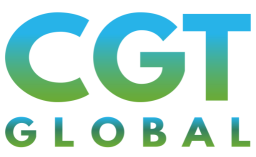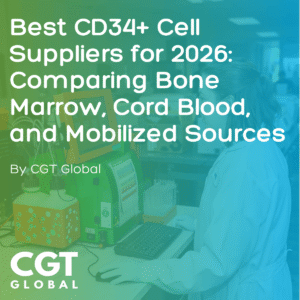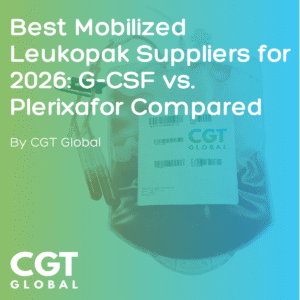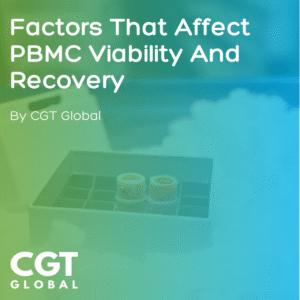Shifting Political Priorities Threaten the Bedrock of Health Science Investment
By: Joanna Wirkus PhD
July 2025
** For scientists under pressure from shifting funding priorities, CGT Global has curated a FREE downloadable funding toolkit with resources to support your long-term funding acquisition strategy. Complete with a grant planning checklist, a curated list of 35+ funding opportunities, and a funding tracking spreadsheet – for preclinical to clinical researchers, visa holders, and graduate student through distinguished professors.
=======================================================================
~50% of global biomedical research is financed by United States public and private funding.

The US National Institutes of Health (NIH) alone invested ~$48 billion into health research in 2024.
Unprecedented budget cuts to the world’s largest biomedical research funder are still unfolding — and while the full consequences remain uncertain, one thing is clear: slashing support for scientific discovery will disrupt progress in human health and deliver lasting harm to society in ways we cannot predict.
These cuts stand in stark contrast to the ambitions of a nation that claims to lead the world in medical innovation.
What is at stake?
NIH funding:
- Led to the discovery of 354/356 or 99% of drugs approved by the Food and Drug Administration (FDA) in 2010-2019
- Fuels the ~$1.5 trillion pharmaceutical and biotechnology sectors
- Supports 2.5-3.5 million jobs in the private and public sectors combined
- Has been estimated to generate a $2.5 economic return for every $1 spent
- Provides critical workforce development for biomedical science through specific trainee grants
- Supports necessary research institution infrastructure including biobanks
What’s the scope?
For nearly 100 years, the NIH has advanced biomedical research. The 2025 Trump administration’s initiated historic funding reductions. No prior cuts have been this far-reaching.
By late February, grant cancelations began with $1.8 billion cut and 694 grants terminated within 6 weeks— an unprecedented timeframe for such severe changes.
The grant-watch.us database reports that ~$4 billion of NIH grant funding has been pulled by July 2025, with >4,400 individual grants cut.
Overrepresented in the top 5 institutions impacted by grant terminations, Harvard Medical School, Harvard School of Public Health, and Harvard University combined have had 637 grants cancelled.
Among the most frequent words in ended grants, “cell” is the second most common.
Terminated Cell and Gene Therapy NIH Grants
While the current administration appears to be favorable towards cell and gene therapy, research projects in this field has also seen their funding cancelled.
Table 1: Examples of titles of terminated NIH cell and gene therapy grants from Grant-Watch.us
| Titles of NIH Grants Terminated |
| Developing HIV Resistant Hematopoietic Stem Cells through Targeted Base Editing |
| Base editing to elucidate RAF regulation and signaling |
| Evaluating the Role of Human Obesity Genes in Specific Neuronal Populations in vivo by CRISPRi |
| Elucidating Host Responses to AAV Ocular Gene Therapy Vectors |
| Self-Assembling Peptide Nanoparticles for in vivo Genome Editor Delivery to Hematopoietic Stem Cells |
| Investigating dysregulation of hematopoietic stem cell support in sickle cell disease mesenchymal stromal cells |
| Translation fidelity as a modulator of hematopoietic stem cell fitness and longevity |
| Examining Health Disparities in the use of Hematopoietic Cell Transplants for HIV-related Lymphoma |
| The developmental origin of adult pluripotent stem cells |
| Defining the role of MET components in vestibular hair cell maturation and gene therapy responsiveness |
| Neural stem cell rejuvenation through single cell pharmacogenomics |
| Viral and immune kinetics in rhinovirus infection following hematopoietic cell transplantation |
| Genome-wide CRISPR-Cas9 screens in insect cells to characterize insecticidal toxins |
| Molecular mechanisms of telomere function in muscle stem cells |
| Rapid functional genetics to study stem cell-niche interactions in the skin |
| Aging and Rejuvenation of Skin Stem Cells |
| Development and validation of novel mouse models and expression vectors for characterizing severe alpha-thalassemia pathophysiology and evaluating gene therapy approaches. |
| Genome editing of human pancreatic islets to withstand ischemic injuries and promote immune evasion |
| Measuring and modeling the dynamics of patterning in human stem cells |
| Investigating the Cell Type- and Receptor-Specific Effects of Erythropoietin that Mediate Erythropoiesis and Thrombopoiesis in Primary Human Hematopoietic Progenitor Cells |
| Stem cell regulation during development and whole-body regeneration |
| Integrating Chemical Genetic Approaches with Precision Genome Editing |
| Investigating the fetal origins of myeloid-biased hematopoietic stem cells |
| Mitochondrial Defects in 22q11.2 Deletion Using a Human-Derived Neuronal Stem Cell Model |
| Effect of inflammation on JAK2 mutant evolution in the hematopoietic system: mathematical models and experiments |
| Ex Vivo Generation of Functional Kidney Tissues for Transplantation |
These large-scale NIH funding cuts have derailed decades of momentum in human health science.
Further cuts to the National Science Foundation’s basic science funding and the Department of Defense’s cancer research budget undermine scientific discovery. For example, any insight into the effects of cellular gene expression changes could inform future cell and gene therapies. Because this fundamental research relies on public funding, the broader impact of defunding science on human health progress is substantial and enduring.
Abrupt funding cuts are leading to further waste. Announcing planned funding reductions with time to adapt gives scientists and institutions the time they need to adjust accordingly.
For patients and their families afflicted with life-limiting conditions, halting the development of new treatments will deprive them of potentially lifesaving therapies.
What’s next?
Some successes in preserving support for research institutions have emerged—such as the federal court’s decision to block the proposed 15% cap on indirect costs in grant funding. Lawsuits challenging canceled research grants are mounting across the country.
Recently, federal judges ordered the reversal of politically motivated grant cuts. Yet, damage has already been done, grantees may face long delays before funds return, and spending reductions still loom over the horizon. Despite widespread opposition, the administration still plans to reduce future funding for biomedical science.
The proposed FY2026 budget for the NIH contains deep funding cuts.
If approved, the spending proposal would decrease NIH funding by about 40%, bringing it back to the 2003 budget level of $27.5 billion.
The 27 current institutes and centers would be pared down to just 8.
While the National Cancer Institute will be spared in the consolidation, its budget has been proposed to be reduced from $7.22 billion to $4.53 billion, a 37% cut.
These future proposals do not adjust for inflation. This constraint means researchers will be asked to do more with less.
While the consequences of research disinvestment are still unfolding, it’s not far-fetched to imagine potential impacts on methodological rigor, data reliability, and reproducibility. Furthermore, the negative downstream impacts on the development of a highly skilled biomedical workforce undermine future innovation.
Can state-level public investment fill the federal funding gap?
In the early 2000s, Bush era federal policies curtailed funding for stem cell research, motivating states to lead public investment in the field.
During that time, New York, Connecticut, New Jersey, Illinois, Maryland, and California launched state funding initiatives for stem cell research.
| State | Stem Cell Research Funding Program Status |
| New York | Discontinued as of 12/31/2025 |
| Connecticut | Transitioned to venture capital fund |
| New Jersey | Announced strategic innovation center for biomedical research in February 2025 |
| Illinois | Executive order in 2005 created the Illinois Regenerative Institute for Stem Cell Research. No current information on this program on Illinois.gov about this program. |
| Maryland | Maryland’s Stem Cell Research Fund has been active since 2006 |
| California | Home to one of the world’s largest funders for regenerative medicine – the California institute for Regenerative Medicine |
Policy makers and advocacy groups need to prioritize sustaining existing state stem cell science funding programs.
Furthermore, states that discontinued similar programs could be prime candidates to revive taxpayer-funded initiatives supporting cell and gene therapy research.
Additionally, new states could emerge as champions of publicly supported scientific progress.
The state of California offers multiple public funding mechanisms for biomedical research and serves as a compelling case study worth exploring.
California State Government Supports Regenerative Medicine
Californians passed Proposition 71 in 2004, allocating $3 billion towards innovative medical research. This funding created CIRM or the California Institute for Regenerative Medicine.
In 2020, the passage of Proposition 14 added $5.5 billion to continue this research.
Importantly, a recent funding opportunity offered $8-15 million for a clinical trial and was open to California or non-Californian private and for-profit organizations.
California State Government Supports Cancer Research with Voluntary Tax Contributions
Since 2018, California taxpayers have had the option to make optional donations to the California Cancer Research Voluntary Tax Contribution Fund. In 2024, $425,000 dollars were raised for cancer research. This program has funded relevant cell and gene therapy related cancer research including ~$95,000 awards to
- “AI based discovery of novel T cell therapies for diverse immunogenetic backgrounds” led by Dr. Vanessa Jönsson at University of California (UC), Santa Cruz
- “Enhancing CAR-T Therapy by Targeting PP2A in Glioblastoma” run by Dr. Rongze Olivia Lu at UC San Francisco
What can be done?
Continuing with the California case study, the California Life Sciences Organization plays a pivotal role in advocating for public investment in life sciences. Organizations like this are crucial for highlighting research successes and promoting further public and private investment in advancing biomedical research.
Similar organizations could pool resources to support coordinated efforts that create and protect funding for cell and gene therapy in other regions or states.
The American Society for Cell and Gene Therapy, a nonprofit funding organization, and the professional industry trade organization the Alliance for Regenerative Medicine have annual federal lobbying budgets in the low to high six-figure range according to OpenSecrets.org. While these national organizations are focused on federal funding priorities, some resources could be directed toward local, state, or university-level policy efforts to support science funding in states ready to advance cell-based medical breakthroughs.
Sources of Funding Beyond Government Support
A few examples of professional and philanthropic organizations that fund cell and gene therapy research include:
- The immunotherapy-focused Cancer Research Institute (CRI) is committing $11.2 million toward cancer research funding this year, up 30% in response to NIH funding cuts. CRI’s CEO Alisha Zhou says this additional $2.5 million will support 10 postdocs.
- The Parker Institute for Cancer Immunotherapy funds early-career researchers.
- The Burroughs Wellcome Fund supports biomedical scientists at the beginning of their careers and areas of science that are poised for significant advancement but are currently undervalued and underfunded.
- The V Foundation offers Ovarian Cancer Research Grant Award Programs.
- Other states that have similar location-based grant programs include the New York Stem Cell Foundation, which offers Extramural Grants.
While funding for NIH grants is highly competitive, the race to secure grants from these prestigious organizations is equally challenging.
Developing strategies to secure funding from multiple sources is key to supporting scientific discovery long term.
Public-private partnerships are becoming increasingly necessary to bring bench discoveries to the patient’s bedside. Pharmaceutical companies will continue to be important supporters of biotechnology commercialization, though their funding typically comes with more restrictions and specific requirements.
Academics are also increasingly approaching venture capital firms for funding support.
Innovative strategies for researchers concerned about long-term funding prospects include exploring alternative funding mechanisms and collaborative partnerships.
Relocation & Developing International Collaborations
Data collected by Nature in March 2025 suggests that many US scientists have considered leaving the country to pursue opportunities abroad. Early career scientists often find it easier to be mobile, making relocation a viable option for them. Established researchers may consider diversifying funding sources and strengthening collaboration networks to secure the long-term future of cell therapy research.
- The European Research Council (ERC) is offering up to €2 million per researcher to conduct research in the European Union.
- Australia’s government invests in stem cell science.
- Canada supports regenerative medicine research.
- Canada’s Stem Cell Network
The International Society for Stem Cell Research curates a comprehensive list of global societies and networks
Scientific Resources — International Society for Stem Cell Research
Crowdfunding
Patient advocacy groups have been a valuable source of crowdfunding momentum, especially for rare pediatric diseases.
- Research – Giant Axonal Neuropathy (GAN) (Hanna’s Hope Fund)
- Our Work — Batten Disease (Mila’s Miracle Foundation)
In 2015, Cell Therapy of Wales set a world record for biotech crowdfunding and raised approximately £700,000 for their breakthrough stem cell medicine, Heartcel.
More recently, Siren Biotechnology is making headlines with Nicole Paulk’s crowdfunding efforts to develop an immunotherapy and gene therapy approach using an adeno-associated viral vector to deliver cytokines into brain and eye tumors.
Fundraisers
Cancer researchers Dr. Azra Raza and Dr. Siddhartha Mukherjee benefited from a concert that supported their research at Columbia University Medical Center.
Conclusion
Financial support fuels scientific progress. Many agree it’s a public benefit worth investing in—because the momentum of science must continue.
With scientists securing only about 1 in 10 grants they apply for—and some federal programs funding ~25% or less of applicants—navigating a long-term grantsmanship strategy is challenging even in the best of times.
We’ve curated a FREE funding toolkit with resources to support scientists in the search for financial support so they may continue to lead scientific innovations aimed at creating the next-generation medicines.
- List of funding opportunities
- Grant planning checklist
- Grant tracking spreadsheet
Follow CGT Global on LinkedIn to stay tuned for our next funding focused blog on Venture Capital: Red Flags for Investors.
——————————————————————————————-
Founded in 2010 by Cate Spears, CGT (Cell and Gene Therapy) Global is on a mission to transform the life sciences and medical industries.
As a leading global provider of human primary cells, bone marrow, cord blood, peripheral blood, and disease-state products, CGT Global expedites research, accelerating clinical trials, streamlining the commercialization process, and broadening patient access to life-changing therapies.
Need a quote for your budget justification?
Contact our team today.
Additional References
1. World RePORT. International Biomedical Research Organization Support.
2. National Institutes of Health. (2024). NIH Budget.
https://www.nih.gov/about-nih/what-we-do/budget
3. Cleary, E.G., Beierlein, J.M., Khanuja, N., et al. (2018). Comparison of Research Spending on New Drug Approvals by the National Institutes of Health vs the Pharmaceutical Industry, 2010–2019. PLoS ONE, 13(2), e0192360.
https://www.ncbi.nlm.nih.gov/pmc/articles/PMC5794820
4. Association of American Medical Colleges. (2020). Every dollar of NIH research funding doubles in economic returns.
https://www.aamc.org/news-insights/every-dollar-nih-research-funding-doubles-economic-returns
5. Science Magazine. (2025). NIH Grants Terminated Amid Trump Administration, Raising Concerns for US Research, Minority Health Disparities.
https://www.sciencemag.org/news/2025/01/nih-grants-terminated-amid-administration-cuts
6. GrantWatch. Database of Federal Grant Cancellations.
7. GrantWatch. (n.d.). Reports on Grant Cancellations.
https://grant-watch.us/reports.html
8. Higher Ed Dive. (2024). Judge Permanently Blocks NIH’s Plan to Cap Funding at 15% Indirect Cost Rate, Setting Up Appeals Battle.
https://www.highereddive.com/news/judge-blocks-nih-indirect-cost-cap
9. Associated Press. (2025). Draft Budget Proposes Deep Cuts to Federal Health Programs.
https://apnews.com/article/federal-health-budget-cuts-2026
10. New York State Department of Health, Wadsworth Center. New York State Stem Cell Science.
https://health.ny.gov/stemcell
11. Garg, A. et al. (2019). Connecticut’s Continuing Role in Advancing Stem Cell Research. Stem Cell Reports, 12(4), 678–685.
https://www.ncbi.nlm.nih.gov/pmc/articles/PMC6778567
12. Yale School of Medicine. (2023). Stem Cell Research Thriving in Connecticut.
https://medicine.yale.edu/stemcell
13. Connecticut Innovations. Regenerative Medicine Research Fund (RMRF) FAQs.
https://ctinnovations.com/RMRF-FAQs.pdf
14. New Jersey Economic Development Authority. (2023). EDA Authorizes First Funds from $270 Million Designated for Stem Cell Research Facilities.
https://www.njeda.com/news/eda-authorizes-first-funds-stem-cell-research
15. New Jersey Economic Development Authority. (2024). NJEDA and Coriell Institute Announce New Innovation Center in Camden.
https://www.njeda.com/news/njeda-coriell-innovation-center
16. Office of the Governor of Illinois. (2005). Executive Order Number 05-06: $10 Million in State Stem Cell Research Grants Announced by Gov. Blagojevich and Comptroller Hynes.
https://www2.illinois.gov/government/executive-orders/2005/05-06.pdf
17. Maryland Stem Cell Research Foundation. About the Foundation.
18. Jasanoff, S. (2005). The California Stem Cell Initiative: Persuasion, Politics, and Public Science. Science, 307(5715), 1960–1961.
https://www.ncbi.nlm.nih.gov/pmc/articles/PMC1298972
19. California Institute for Regenerative Medicine (CIRM). About Us.
20. University of California Research Initiatives (UCRI). California Cancer Research Voluntary Tax Contribution Fund.
https://ucri.universityofcalifornia.edu/cancer-fund
21. American Society of Gene & Cell Therapy (ASGCT). About ASGCT.
22. OpenSecrets. (2024). American Society of Gene & Cell Therapy Lobbying Profile.
https://www.opensecrets.org/orgs/summary?id=D000054031
23. Alliance for Regenerative Medicine. About the Alliance.
24. OpenSecrets. (2024). Alliance for Regenerative Medicine Profile.






